Review: Simple Random Sampling
Do you remember how simple random sampling works? Visually, it's just numbering each individual and randomly selecting a certain number of them. Here's the image we used in the previous section:
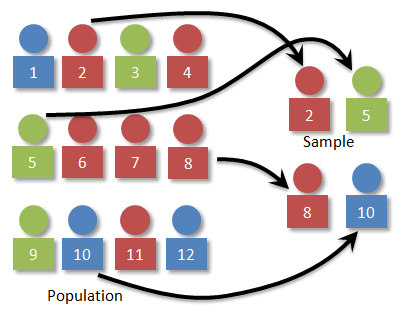
Stratified Sampling
Stratified sampling is different. With this technique, we separate the population using some characteristic, and then take a proportional random sample from each.
A stratified sample is obtained by separating the population into non-overlapping groups called strata and then obtaining a proportional simple random sample from each group. The individuals within each group should be similar in some way.
Visually, it might look something like the image below. With our population, we can easily separate the individuals by color.
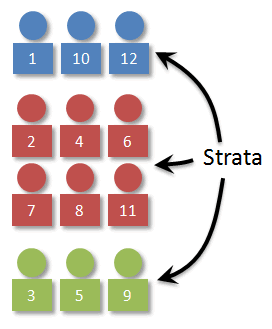
Once we have the strata determined, we need to decide how many individuals to select from each stratum. (Man, that's a weird word!) The key here is that the number selected should beproportional. In our case, 1/4 of the individuals in the population are blue, so 1/4 of the sample should be blue as well. Working things out, we can see that a stratified (by color) random sample of 4 should have 1 blue, 1 green, and 2 reds.
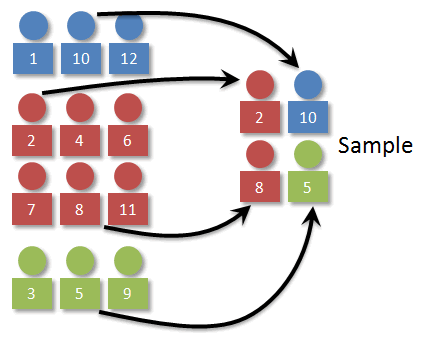
Example 1
One easy example using a stratified technique would be a sampling of people at ECC. To make sure that a sufficient number of students, faculty, and staff are selected, we would stratify all individuals by their status - students, faculty, or staff. (These are the strata.) Then, a proportional number of individuals would be selected from each group.
Systematic Sampling
A systematic sample is obtained by selecting every kth individual from the population. The first individual selected corresponds to a random number between 1 and k.
So to use systematic sampling, we need to first order our individuals, then select every kth. (More on how to select k in a bit.)

In our example, we want to use 3 for k? Can you see why? Think what would happen if we used 2 or 4.
For our starting point, we pick a random number between 1 and k. For our visual, let's suppose that we pick 2. The individuals sampled would then be 2, 5, 8, and 11.
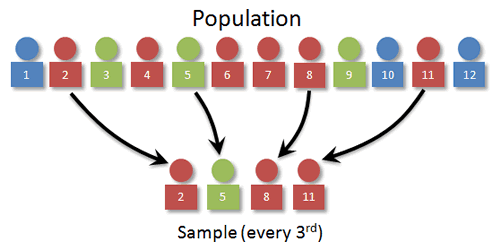
In general we find k by taking N/n and rounding down to the nearest integer.
Example 2
Systematic sampling works well when the individuals are already lined up in order. In the past, students have often used this method when asked to survey a random sample of ECC students. Since we don't have access to the complete list, just stand at a corner and pick every 10th* person walking by.
* Of course, choosing 10 here is just an example. It would depend on the number of students typically passing by that spot and what sample size was needed.
Cluster Sampling
Cluster sampling is often confused with stratified sampling, because they both involve "groups". In reality, they're very different. In stratified sampling, we split the population up into groups (strata) based on some characteristic.
So to use systematic sampling, we need to first order our individuals, then select every kth. (More on how to select k in a bit.)

In our example, we want to use 3 for k? Can you see why? Think what would happen if we used 2 or 4.
For our starting point, we pick a random number between 1 and k. For our visual, let's suppose that we pick 2. The individuals sampled would then be 2, 5, 8, and 11.

In general we find k by taking N/n and rounding down to the nearest integer.
For another take, watch this YouTube video:
Example 2
Systematic sampling works well when the individuals are already lined up in order. In the past, students have often used this method when asked to survey a random sample of ECC students. Since we don't have access to the complete list, just stand at a corner and pick every 10th* person walking by.
* Of course, choosing 10 here is just an example. It would depend on the number of students typically passing by that spot and what sample size was needed.
Cluster Sampling
Cluster sampling is often confused with stratified sampling, because they both involve "groups". In reality, they're very different. In stratified sampling, we split the population up into groups (strata) based on some characteristic.
A cluster sample is obtained by selecting all individuals within a randomly selected collection or group of individuals.
In essence, we use cluster sampling when our population is already broken up into groups (clusters), and each cluster represents the population. That way, we just select a certain number of clusters.
With our visual, let's suppose the 12 individuals are paired up just as they were sitting in the original population.

Since we want a random sample of size four, we just select two of the clusters. We would number the clusters 1-6 and use technology to randomly select two random numbers. It might look something like this:
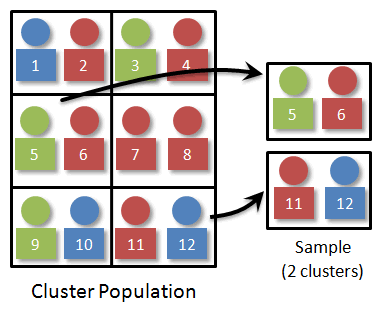
Example 3
One situation where cluster sampling would apply might be in manufacturing. Suppose your company makes light bulbs, and you'd like to test the effectiveness of the packaging. You don't have a complete list, so simple random sampling doesn't apply, and the bulbs are already in boxes, so you can't order them to use systematic. And all the bulbs are essentially the same, so there aren't any characteristics with which to stratify them.
To use cluster sampling, a quality control inspector might select a certain number of entire boxes of bulbs and test each bulb within those boxes. In this case, the boxes are theclusters.
Convenience Sampling
Other methods do exist for finding samples of populations. In fact, you've seen some already. Probably the most common is the so-called convenience sample. Convenience samples are just what they sound like - convenient. Unfortunately, they're rarely representative. Think of the radio call-in show, those people in the shopping malls trying to survey you about your purchasing habits, or even the voting on American Idol!
Here's a specific example. It's a poll on beliefnet.com, titled "What Evangelicals Want". All online polls use, by nature, convenience sampling. According to the article, "The poll was promoted on Beliefnet’s web site and through its newsletters." Only those evangelicals who visit this particular web site and actually answer the survey are included. Beware any poll result taken with convenience sampling.
Multistage Sampling
Often one technique isn't possible, so many professional polling agencies use a technique called multistage sampling. The strategy is relatively self-explanatory - two or more sampling techniques are used.
For example, consider the light-bulb example we looked at earlier with cluster sampling. Let's suppose that the bulbs come off the assembly line in boxes that each contain 20 packages of four bulbs each. One strategy would be to do the sample in two stages:
Stage 1: A quality control engineer removes every 200th box coming off the line. (The plant produces 5,000 boxes daily. (This is systematic sampling.)
Stage 2: From each box, the engineer then samples three packages to inspect. (This is an example of cluster sampling.)
The US Census also uses multistage sampling. If you haven't already (you should have!), read Section 1.4 in your text for more details.
Summary
Here's a visual summary of the four main sampling strategies:
Simple Random: |  |
Stratified: |  |
Systematic: | 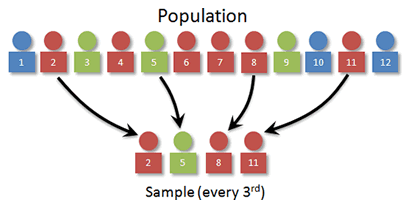 |
Cluster: |  |
Great post!
ReplyDeleteI spent a lot of time creating this content. Please don't steal things and pass them off as your own.
ReplyDeletehttps://faculty.elgin.edu/dkernler/statistics/ch01/1-4.html